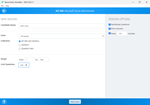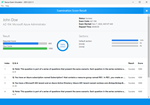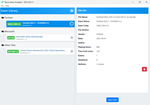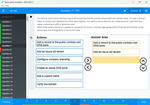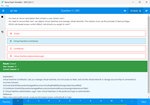Download Data Center Professional.JN0-683.PassLeader.2025-03-31.20q.tqb
| Vendor: | Juniper |
| Exam Code: | JN0-683 |
| Exam Name: | Data Center Professional |
| Date: | Mar 31, 2025 |
| File Size: | 89 KB |
How to open TQB files?
Files with TQB (Taurus Question Bank) extension can be opened by Taurus Exam Studio.
Purchase
Coupon: TAURUSSIM_20OFF
Discount: 20%
Demo Questions
Question 1
You are deploying an IP fabric with an oversubscription ratio of 3:1. In this scenario, which two statements are correct? (Choose two.)
- The oversubscription ratio decreases when you add leaf devices.
- The oversubscription ratio remains the same when you remove leaf devices.
- The oversubscription ratio increases when you remove leaf devices.
- The oversubscription ratio remains the same when you add leaf devices.
Correct answer: CD
Explanation:
1. Understanding Oversubscription Ratio in IP Fabrics:The oversubscription ratio in an IP fabric typically refers to the ratio of the available bandwidth at the edge of the network (leaves) to the available bandwidth at the core or spine. A 3:1 oversubscription ratio means that for every 3 units of bandwidth at the leaves, there is 1 unit of bandwidth at the spine.2. Impact of Adding or Removing Leaf Devices:– Removing Leaf Devices: When you remove leaf devices, the amount of total edge bandwidth decreases while the bandwidth in the spine remains constant. This causes the oversubscription ratio to increase because there is now less total bandwidth to distribute across the same amount of spine bandwidth.– Adding Leaf Devices: Conversely, when you add leaf devices, the total edge bandwidth increases.Since the spine bandwidth remains the same, the oversubscription ratio would remain the same if the additional leaves consume their share of the available bandwidth proportionally.3. Conclusion:Option C is correct: Removing leaf devices increases the oversubscription ratio.Option D is correct: Adding leaf devices typically maintains the oversubscription ratio assuming uniform bandwidth distribution. 1. Understanding Oversubscription Ratio in IP Fabrics:
The oversubscription ratio in an IP fabric typically refers to the ratio of the available bandwidth at the edge of the network (leaves) to the available bandwidth at the core or spine. A 3:1 oversubscription ratio means that for every 3 units of bandwidth at the leaves, there is 1 unit of bandwidth at the spine.
2. Impact of Adding or Removing Leaf Devices:
– Removing Leaf Devices: When you remove leaf devices, the amount of total edge bandwidth decreases while the bandwidth in the spine remains constant. This causes the oversubscription ratio to increase because there is now less total bandwidth to distribute across the same amount of spine bandwidth.
– Adding Leaf Devices: Conversely, when you add leaf devices, the total edge bandwidth increases.
Since the spine bandwidth remains the same, the oversubscription ratio would remain the same if the additional leaves consume their share of the available bandwidth proportionally.
3. Conclusion:
Option C is correct: Removing leaf devices increases the oversubscription ratio.
Option D is correct: Adding leaf devices typically maintains the oversubscription ratio assuming uniform bandwidth distribution.
Question 2
You are asked to identify microburst traffic occurring in the network leading lo packet drops in your data center switches Which two tools would be used in this scenario? (Choose two.)
- port mirroring
- traceoptions
- port buffer monitoring
- syslog
Correct answer: AC
Explanation:
1. Identifying Microburst Traffic:Microbursts are short spikes in network traffic that can overwhelm buffers and cause packet drops. Detecting and analyzing microbursts is crucial for understanding where packet loss might be occurring in a data center network.2. Port Buffer Monitoring:This tool specifically tracks the usage of switch buffers, helping to identify when microbursts are causing buffers to overflow, leading to packet drops.3. Port Mirroring:This tool allows you to monitor real-time traffic on a specific port by copying the traffic to another port where it can be analyzed, often with a packet analyzer. While port mirroring doesn’t directly detect microbursts, it helps capture traffic patterns that can indicate microbursts.4. Conclusion:Option C is correct: Port buffer monitoring directly identifies buffer overflows caused by microbursts.Option A is correct: Port mirroring allows for the detailed capture and analysis of traffic patterns, which can reveal microburst behavior.Options B (Traceoptions) and D (Syslog) are less effective in identifying microburst traffic. Traceoptions focus on control plane traffic debugging, and Syslog is more about logging system events than detecting high-frequency traffic spikes. 1. Identifying Microburst Traffic:
Microbursts are short spikes in network traffic that can overwhelm buffers and cause packet drops. Detecting and analyzing microbursts is crucial for understanding where packet loss might be occurring in a data center network.
2. Port Buffer Monitoring:
This tool specifically tracks the usage of switch buffers, helping to identify when microbursts are causing buffers to overflow, leading to packet drops.
3. Port Mirroring:
This tool allows you to monitor real-time traffic on a specific port by copying the traffic to another port where it can be analyzed, often with a packet analyzer. While port mirroring doesn’t directly detect microbursts, it helps capture traffic patterns that can indicate microbursts.
4. Conclusion:
Option C is correct: Port buffer monitoring directly identifies buffer overflows caused by microbursts.
Option A is correct: Port mirroring allows for the detailed capture and analysis of traffic patterns, which can reveal microburst behavior.
Options B (Traceoptions) and D (Syslog) are less effective in identifying microburst traffic. Traceoptions focus on control plane traffic debugging, and Syslog is more about logging system events than detecting high-frequency traffic spikes.
Question 3
Which two statements are true about a pure IP fabric? (Choose two.)
- Devices in an IP fabric function as Layer 3 routers.
- An IP fabric supports Layer 2 VLANs.
- Devices in an IP fabric must be connected to a fabric controller.
- An IP fabric does not support Layer 2 protocols.
Correct answer: AD
Explanation:
1. Understanding Pure IP Fabric:A pure IP fabric is a network design where all devices operate at Layer 3, meaning that each device in the fabric is a router that makes forwarding decisions based on IP addresses.2. Layer 2 Support:In a pure IP fabric, traditional Layer 2 protocols such as Spanning Tree Protocol (STP) or VLANs are not supported. Instead, the network relies entirely on Layer 3 routing protocols to manage traffic between devices.3. Routing Functionality:Since devices in an IP fabric operate as Layer 3 routers, they handle IP routing and provide network services based on IP addresses, not on MAC addresses or Layer 2 switching.4. Conclusion:Option A is correct: Devices in an IP fabric function as Layer 3 routers.Option D is orrect: A pure IP fabric does not support traditional Layer 2 protocols, making it a purely routed environment. 1. Understanding Pure IP Fabric:
A pure IP fabric is a network design where all devices operate at Layer 3, meaning that each device in the fabric is a router that makes forwarding decisions based on IP addresses.
2. Layer 2 Support:
In a pure IP fabric, traditional Layer 2 protocols such as Spanning Tree Protocol (STP) or VLANs are not supported. Instead, the network relies entirely on Layer 3 routing protocols to manage traffic between devices.
3. Routing Functionality:
Since devices in an IP fabric operate as Layer 3 routers, they handle IP routing and provide network services based on IP addresses, not on MAC addresses or Layer 2 switching.
4. Conclusion:
Option A is correct: Devices in an IP fabric function as Layer 3 routers.
Option D is orrect: A pure IP fabric does not support traditional Layer 2 protocols, making it a purely routed environment.
Question 4
You are asked to deploy 100 QFX Series devices using ZTP Each OFX5120 requires a different configuration. In this scenario, what are two components that you would configure on the DHCP server? (Choose two.)
- the IP address of the FTP server
- the MAC address for each OFX5120
- the MAC address of the FTP server
- the management IP address for each OFX5120
Correct answer: BD
Explanation:
1. Zero Touch Provisioning (ZTP):ZTP allows for the automated configuration of network devices, like QFX Series switches, without manual intervention. During ZTP, a switch will obtain its configuration from a DHCP server and then download the required software and configuration files from a specified server (e.g., FTP, HTTP).2. DHCP Server Configuration:– The DHCP server needs to know the MAC address for each QFX5120 to provide a specific configuration based on the device identity. By mapping the MAC address to a particular configuration, the DHCP server can ensure that each switch gets the correct configuration.– The management IP address for each QFX5120 must also be assigned by the DHCP server. This IP address allows the device to communicate on the network and access the configuration files and other required resources during the ZTP process.3. Conclusion:Option B is correct: MAC addresses allow the DHCP server to identify each QFX5120 and assign the appropriate configuration.Option D is correct: Management IP addresses are essential for network communication during ZTP. 1. Zero Touch Provisioning (ZTP):
ZTP allows for the automated configuration of network devices, like QFX Series switches, without manual intervention. During ZTP, a switch will obtain its configuration from a DHCP server and then download the required software and configuration files from a specified server (e.g., FTP, HTTP).
2. DHCP Server Configuration:
– The DHCP server needs to know the MAC address for each QFX5120 to provide a specific configuration based on the device identity. By mapping the MAC address to a particular configuration, the DHCP server can ensure that each switch gets the correct configuration.
– The management IP address for each QFX5120 must also be assigned by the DHCP server. This IP address allows the device to communicate on the network and access the configuration files and other required resources during the ZTP process.
3. Conclusion:
Option B is correct: MAC addresses allow the DHCP server to identify each QFX5120 and assign the appropriate configuration.
Option D is correct: Management IP addresses are essential for network communication during ZTP.
Question 5
You are deploying multiple Juniper switches al the same location. Your switches are currently using the factory-default configuration. In this scenario, which two statements are correct? (Choose two.)
- The DHCP server configuration cannot provide Junos version requirements to DHCP clients.
- The switch will try to request an IP address from a DHCP server using all interfaces that are connected and are operational.
- The switch will try to request an IP address from a DHCP server using only the management interface.
- The DHCP server configuration can provide Junos version requirements to DHCP clients.
Correct answer: BD
Explanation:
1. DHCP Behavior in Factory-Default Configuration:– In the factory-default configuration, Juniper switches are designed to send DHCP requests on all operational interfaces. This behavior ensures that the switch can obtain an IP address for management and further configuration from any available DHCP server.– The DHCP server can provide additional configuration parameters, including the required Junos version. This allows for automated provisioning and ensures that the switch is running the correct software version.2. Conclusion:Option B is correct: The switch will use any operational interface to request an IP address via DHCP.Option D is correct: The DHCP server can specify Junos version requirements, enabling automated software management. 1. DHCP Behavior in Factory-Default Configuration:
– In the factory-default configuration, Juniper switches are designed to send DHCP requests on all operational interfaces. This behavior ensures that the switch can obtain an IP address for management and further configuration from any available DHCP server.
– The DHCP server can provide additional configuration parameters, including the required Junos version. This allows for automated provisioning and ensures that the switch is running the correct software version.
2. Conclusion:
Option B is correct: The switch will use any operational interface to request an IP address via DHCP.
Option D is correct: The DHCP server can specify Junos version requirements, enabling automated software management.
Question 6
You are deploying a Clos IP fabric with an oversubscription ratio of 3:1. In this scenario, which two statements are correct? (Choose two.)
- The oversubscription ratio remains the same when you remove spine devices.
- The oversubscription ratio decreases when you add spine devices.
- The oversubscription ratio increases when you remove spine devices.
- The oversubscription ratio remains the same when you add spine devices.
Correct answer: BC
Explanation:
1. Understanding Oversubscription in a Clos Fabric:The oversubscription ratio in a Clos IP fabric measures the ratio of the amount of edge (leaf) bandwidth to the core (spine) bandwidth. An oversubscription ratio of 3:1 means that there is three times more edge bandwidth compared to core bandwidth.2. Impact of Adding/Removing Spine Devices:If you remove spine devices, the total available core bandwidth decreases, while the edge bandwidth remains the same. This results in an increase in the oversubscription ratio because there is now less core bandwidth to handle the same amount of edge traffic. Conversely, if you add spine devices, the total core bandwidth increases. This decreases the oversubscription ratio because more core bandwidth is available to handle the edge traffic.3. Conclusion:Option C is correct: Removing spine devices increases the oversubscription ratio.Option B is correct: Adding spine devices decreases the oversubscription ratio. 1. Understanding Oversubscription in a Clos Fabric:
The oversubscription ratio in a Clos IP fabric measures the ratio of the amount of edge (leaf) bandwidth to the core (spine) bandwidth. An oversubscription ratio of 3:1 means that there is three times more edge bandwidth compared to core bandwidth.
2. Impact of Adding/Removing Spine Devices:
If you remove spine devices, the total available core bandwidth decreases, while the edge bandwidth remains the same. This results in an increase in the oversubscription ratio because there is now less core bandwidth to handle the same amount of edge traffic. Conversely, if you add spine devices, the total core bandwidth increases. This decreases the oversubscription ratio because more core bandwidth is available to handle the edge traffic.
3. Conclusion:
Option C is correct: Removing spine devices increases the oversubscription ratio.
Option B is correct: Adding spine devices decreases the oversubscription ratio.
Question 7
You are asked to interconnect Iwo data centers using a method that provides EVPN Type 2 connectivity, is highly scalable, and limits VXLAN tunnels between border leaf devices. What will satisfy these requirements?
- over the top full-mesh interconnect
- EVPN Type 2 stretch
- IP VPN
- Type 2 seamless stitching
Correct answer: D
Explanation:
1. Requirement Analysis:The scenario requires a solution to interconnect two data centers that supports EVPN Type 2 connectivity. The solution must be highly scalable and must minimize the number of VXLAN tunnels between border leaf devices.2. Understanding Type 2 Seamless Stitching:Type 2 seamless stitching is a method used in EVPN to provide Layer 2 connectivity (such as MAC address mobility) across different VXLAN segments. It is scalable because it allows only necessary tunnels to be established between border leaf devices, reducing the overhead of maintaining a full mesh of VXLAN tunnels.3. Conclusion:Option D is correct: Type 2 seamless stitching satisfies the requirement by enabling scalable, efficient interconnection of two data centers with minimal VXLAN tunnels. 1. Requirement Analysis:
The scenario requires a solution to interconnect two data centers that supports EVPN Type 2 connectivity. The solution must be highly scalable and must minimize the number of VXLAN tunnels between border leaf devices.
2. Understanding Type 2 Seamless Stitching:
Type 2 seamless stitching is a method used in EVPN to provide Layer 2 connectivity (such as MAC address mobility) across different VXLAN segments. It is scalable because it allows only necessary tunnels to be established between border leaf devices, reducing the overhead of maintaining a full mesh of VXLAN tunnels.
3. Conclusion:
Option D is correct: Type 2 seamless stitching satisfies the requirement by enabling scalable, efficient interconnection of two data centers with minimal VXLAN tunnels.
Question 8
You are implementing seamless stitching between two data centers and have a proposed configuration for a border leaf device. In this scenario, which two statements are correct? (Choose two.)
- The translation-vni must match in both data centers.
- The translation-vni must be different in each data center.
- The ESI must be different in each data center.
- The ESI must match in both data centers.
Correct answer: BD
Explanation:
1. Understanding Seamless Stitching:Seamless stitching is used in EVPN to interconnect two data centers, allowing for consistent Layer 2 and Layer 3 connectivity across them. This is often achieved by translating VNIs (Virtual Network Identifiers) between the data centers.2. Translation-VNI:The translation VNI must be different in each data center to ensure that traffic can be correctly routed and distinguished as it crosses between the data centers. This differentiation helps to maintain the integrity of the traffic flows and prevents any potential overlap or conflict in VNIs.3. Ethernet Segment Identifier (ESI):The ESI must match in both data centers to ensure that the same Ethernet segment (which could be multihomed) is recognized consistently across the data centers. Matching ESIs are crucial for maintaining a unified view of the Ethernet segment across the interconnected fabric.Conclusion:Option B is correct: Translation VNIs must be unique to each data center for proper traffic distinction.Option D is correct: Matching ESIs are necessary to maintain consistent Ethernet segment identification across both data centers. 1. Understanding Seamless Stitching:
Seamless stitching is used in EVPN to interconnect two data centers, allowing for consistent Layer 2 and Layer 3 connectivity across them. This is often achieved by translating VNIs (Virtual Network Identifiers) between the data centers.
2. Translation-VNI:
The translation VNI must be different in each data center to ensure that traffic can be correctly routed and distinguished as it crosses between the data centers. This differentiation helps to maintain the integrity of the traffic flows and prevents any potential overlap or conflict in VNIs.
3. Ethernet Segment Identifier (ESI):
The ESI must match in both data centers to ensure that the same Ethernet segment (which could be multihomed) is recognized consistently across the data centers. Matching ESIs are crucial for maintaining a unified view of the Ethernet segment across the interconnected fabric.
Conclusion:
Option B is correct: Translation VNIs must be unique to each data center for proper traffic distinction.
Option D is correct: Matching ESIs are necessary to maintain consistent Ethernet segment identification across both data centers.
Question 9
You are asked for TX and RX traffic statistics for each interface to which an application server is attached. The statistics need to be reported every five seconds. Using the Junos default settings, which telemetry method would accomplish this request?
- gNMI
- SNMP
- Native Sensors
- OpenConfig
Correct answer: C
Explanation:
1. Telemetry Methods in Junos:Telemetry is used to collect and report data from network devices. For high-frequency statistics reporting, such as every five seconds, you need a telemetry method that supports this level of granularity and real-time monitoring.2. Junos Native Sensors:Native Sensors in Junos provide detailed, high-frequency telemetry data, including TX and RX traffic statistics for interfaces. They are designed to offer real-time monitoring with customizable sampling intervals, making them ideal for the five-second reporting requirement.3. Conclusion:Option C is correct: Native Sensors in Junos are capable of providing the required high-frequency telemetry data every five seconds. 1. Telemetry Methods in Junos:
Telemetry is used to collect and report data from network devices. For high-frequency statistics reporting, such as every five seconds, you need a telemetry method that supports this level of granularity and real-time monitoring.
2. Junos Native Sensors:
Native Sensors in Junos provide detailed, high-frequency telemetry data, including TX and RX traffic statistics for interfaces. They are designed to offer real-time monitoring with customizable sampling intervals, making them ideal for the five-second reporting requirement.
3. Conclusion:
Option C is correct: Native Sensors in Junos are capable of providing the required high-frequency telemetry data every five seconds.
Question 10
Which three statements are correct about VXLAN control planes? (Choose three.)
- EVPN is inefficient and does not scale well.
- Both multicast and EVPN can facilitate MAC learning.
- Multicast is not agile and requires manual VNI mapping.
- EVPN enables fast convergence and updates.
- Multicast does not require as many resources.
Correct answer: BDE
Explanation:
1. VXLAN Control Planes:VXLAN (Virtual Extensible LAN) uses different control planes to handle MAC learning and traffic forwarding. The control planes include multicast and EVPN (Ethernet VPN).2. Multicast and EVPN Comparison:Both multicast and EVPN can be used for MAC learning in a VXLAN environment. Multicast is a more traditional approach, while EVPN is more advanced and supports distributed MAC learning. EVPN offers benefits such as fast convergence and rapid updates, making it more efficient and scalable for modern data center environments. Multicast does not require as many resources because it relies on traditional Layer 3 multicast mechanisms to distribute broadcast, unknown unicast, and multicast (BUM) traffic. However, it can be less flexible and less scalable compared to EVPN.3. Conclusion:Option B is correct: Both control planes facilitate MAC learning.Option D is correct: EVPN provides fast convergence and updates.Option E is correct: Multicast is resource-efficient but less flexible. 1. VXLAN Control Planes:
VXLAN (Virtual Extensible LAN) uses different control planes to handle MAC learning and traffic forwarding. The control planes include multicast and EVPN (Ethernet VPN).
2. Multicast and EVPN Comparison:
Both multicast and EVPN can be used for MAC learning in a VXLAN environment. Multicast is a more traditional approach, while EVPN is more advanced and supports distributed MAC learning. EVPN offers benefits such as fast convergence and rapid updates, making it more efficient and scalable for modern data center environments. Multicast does not require as many resources because it relies on traditional Layer 3 multicast mechanisms to distribute broadcast, unknown unicast, and multicast (BUM) traffic. However, it can be less flexible and less scalable compared to EVPN.
3. Conclusion:
Option B is correct: Both control planes facilitate MAC learning.
Option D is correct: EVPN provides fast convergence and updates.
Option E is correct: Multicast is resource-efficient but less flexible.
HOW TO OPEN VCE FILES
Use VCE Exam Simulator to open VCE files
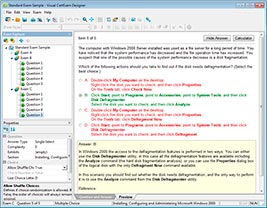
HOW TO OPEN VCEX FILES
Use ProfExam Simulator to open VCEX files
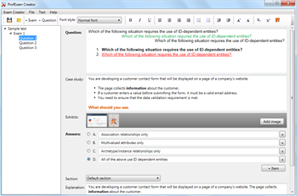
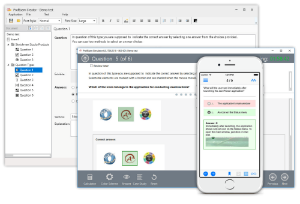
ProfExam at a 20% markdown
You have the opportunity to purchase ProfExam at a 20% reduced price
Get Now!